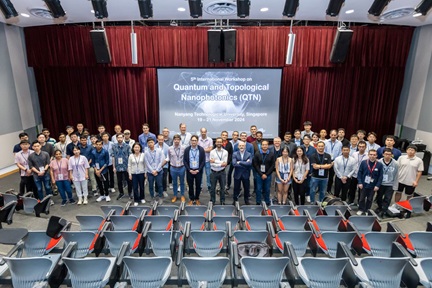Self-Assembled Monolayers (SAMs): 2022 Kavli Prize in Nanoscience
Nanyang Assistant Professor Lee Hiang Kwee | School of Chemistry, Chemical Engineering and Biotechnology, NTU

The ability to modify touch could greatly influence how we perceive and interact with materials. For instance, we can easily increase the adhesive property of our skin by attaching a thin piece of double-sided tape onto it. This simple childhood game allows us to stick onto an object while maintaining the skin’s innate ability to sense roughness and temperature.
In the realm of (nano)materials, the ability to tailor a material’s surface is also crucial to change its properties and imbue desired functionality. However, it was a challenge to create an ultrathin and uniform coating, especially at the (sub)-nanometre regime. The 2022 Kavli Prize in Nanoscience was awarded to four pioneers for their development of self-assembled monolayers (SAMs) on material surfaces.[1] This ground-breaking discovery in molecular coating enables the unprecedented control and precise design of surface properties for diverse applications, ranging from electronic devices to medical diagnostics.
Winners of the 2022 Kavli Prize in Nanoscience

[From left] Prof Jacob Sagiv, for the fabrication of SAMs that are covalently bonded to oxide surfaces. Prof Ralph Nuzzo, for the realization of strongly-bound SAMs on bare metal surfaces. Prof David Allara, for the elucidation of the molecular structure of SAMs using optical spectroscopies and other characterization techniques. Prof George Whitesides, for leading the development and innovation of SAM applications. Image source from reference [1].
In the 1930s, the organisation of molecules at liquid-gas interfaces (Langmuir-Blodgett films) was demonstrated to form a monolayer film that can be transferred onto a material.[2] Building on this concept, Prof Jacob Sagiv achieved a notable breakthrough in 1980 by evidently showing that a molecular monolayer can be directly formed by adsorption from a solvent.[3] His seminal work reported the formation of well-defined SAMs using silane-terminated molecules on a material surface containing oxygen groups. This is a major discovery considering that most surfaces are naturally coated with an oxide layer. He further expanded the types of molecules that could be incorporated within the SAMs to customize a material with target functionality, such as fluorescence and wetting properties.
In the 1980s, follow-up work done by Prof Ralph Nuzzo and Prof David Allara highlighted the first SAMs of sulfur-containing hydrocarbons on bare metal surfaces.[4] Using infrared and other spectroscopic techniques, they highlighted the spontaneous assembly of these molecules into a two-dimensional SAM on a metal surface via strong metal-sulfur interaction. They have also uncovered the packing and orientation of the SAMs, thereby elucidating critical insights for the rational design of functional SAMs.
Self-assembled monolayer and its application in soft lithography
 [Left] Self-assembled monolayer on a material surface. [Right] Anisotropically etched silicon substrate with microscale pyramidal pits fabricated using soft lithography.
Reprinted (adapted) with permission from
[5]. Copyright 2004 American Chemical Society.
[Left] Self-assembled monolayer on a material surface. [Right] Anisotropically etched silicon substrate with microscale pyramidal pits fabricated using soft lithography.
Reprinted (adapted) with permission from
[5]. Copyright 2004 American Chemical Society.
Prof George Whitesides and his team subsequently led the development and innovation of many SAM applications in the field of nanoscience and engineering.[5,6] One notable accomplishment was the introduction of nanometre-scale patterning of surfaces with SAMs, a technique later known as soft lithography. In this technique, a patterned SAM is formed on a target metal film to yield a protective coating that prevents the underlying metal from being etched off by a reactive agent. Subsequent removal of the unprotected metal effectively transfers the pre-defined SAM pattern onto the gold to create metal configurations with different shapes and sizes.
The work by the four pioneers in SAMs jointly empowers us with the ability to design and fabricate surfaces with precise functionality. The plethora of scientific and technological knowledge on SAMs provides a strong impetus in modern high-tech industries, where SAMs are widely employed in medical diagnostics, energy harvesting and storage materials, electronic manufacturing, and (bio)chemical sensors. The multibillion-dollar market clearly highlights the importance of SAMs, how they have shaped our daily lives, and the long-term impact of this technology.
[1] https://www.kavliprize.org/prizes/nanoscience/2022
[2] K.B. Blodgett, J. Am. Chem. Soc., 1935, 57, 1007-1022.
[3] J. Sagiv, J. Am. Chem. Soc., 1980, 102, 92-98.
[4] R.G. Nuzzo and D.L. Allara, J. Am. Chem. Soc., 1983, 105, 4481-4483.
[5] Q. Xu, I. Tonks, M.J. Fuerstman, J.C. Love, and G.M. Whitesides, Nano Lett., 2004, 4, 2509-2511.
[6] A. Kumar, H.A. Biebuyck, N.L. Abbott, and G.M. Whitesides, J. Am. Chem. Soc., 1992, 114, 9188-9189.
Find out more about the Kavli Prize:














/enri-thumbnails/careeropportunities1f0caf1c-a12d-479c-be7c-3c04e085c617.tmb-mega-menu.jpg?Culture=en&sfvrsn=d7261e3b_1)

/cradle-thumbnails/research-capabilities1516d0ba63aa44f0b4ee77a8c05263b2.tmb-mega-menu.jpg?Culture=en&sfvrsn=1bc94f8_1)






